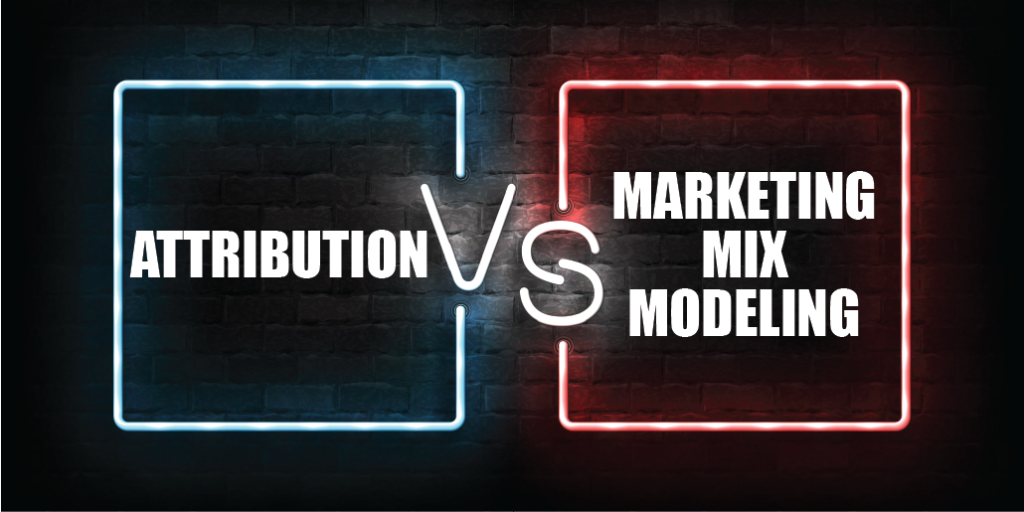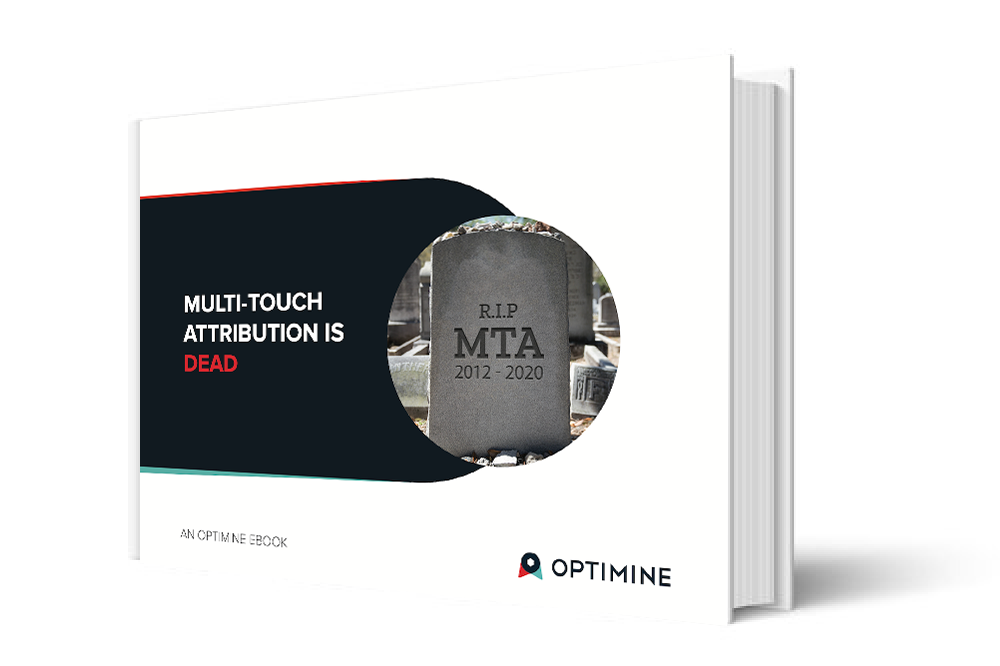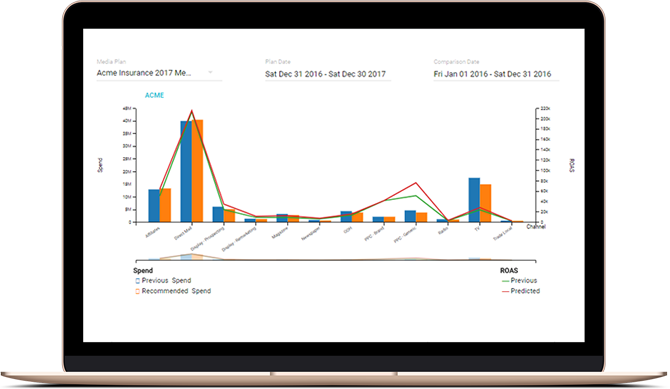Contents
- Table of Contents:
- What are the Main Differences Between Marketing Attribution and Marketing Mix Modeling?
- Comparison: Attribution Modeling vs. Marketing Mix Modeling
- What is Marketing Attribution?
- When to Use Marketing Attribution
- Types of Marketing Attribution Models
- Pros of Marketing Attribution
- Cons of Marketing Attribution
- What is Marketing Mix Modeling (MMM)?
- When to Use MMM
- Types of Marketing Mix Modeling
- Pros of Traditional MMM
- Cons of Traditional MMM
- Attribution Modeling vs. Marketing Mix Modeling: Which is Better?
- The Best Option: A New, Modern Approach to MMM
Marketing Mix Modeling vs. Attribution
06/03/2022

There are many challenges facing marketers today. One of the greatest is the continuous outpour of privacy changes and regulations. These ever-mutating policies are problematic on so many levels but critical when the data-loss impacts measurement. Now, add channel complexity and marketers are faced with a whole new level of difficulty when trying to accurately measure advertising performance.
Thankfully, there are two main approaches to solve for these evolving barriers: marketing attribution or marketing mix modeling (MMM). But before choosing an approach, the key consideration is data availability (or lack thereof). OptiMine will dive deep into these two common solutions to help you figure out which type of marketing measurement is best for you and your brand.
Here’s a brief overview before we go in-depth on the key differences between the two approaches: attribution focuses more on individual user interactions but is struggling amid consumer privacy changes and regulations, whereas marketing mix modeling takes more of a top-down, macro-level view and is not impacted by the continuous stream of privacy changes because MMM doesn’t use any type of identity data.
Table of Contents:
What are the Main Differences Between Marketing Attribution and Marketing Mix Modeling?
Comparison: Attribution vs. Marketing Mix Modeling
What is Marketing Attribution?
What is Marketing Mix Modeling?
Attribution Modeling vs. Marketing Mix Modeling: Which is Better?
The Best Option: A New, Modern Approach to MMM
What are the Main Differences Between Marketing Attribution and Marketing Mix Modeling?
Attribution focuses more on individual user interactions, while marketing mix modeling takes more of a top-down, macro-level view (draws on marketing and sales data, revenue, benchmarks, costs, outside factors, etc.).
Additionally, marketing mix modeling solutions (such as OptiMine) are future-proof in the sense that they are completely unaffected by the plethora of consumer privacy changes and regulations, while marketing attribution is being completely disrupted by these same changes and regulations.
Comparison: Attribution Modeling vs. Marketing Mix Modeling
| Attribution Modeling | Marketing Mix Modeling |
|
Uses individual identity data |
Uses regression models |
|
Is negatively affected by new consumer privacy changes and regulations |
Is unaffected by new consumer privacy changes and regulations |
|
Creates (financial and legal) risks for your brand through the use of identity tracking methods if not in compliance with privacy regulations |
No financial or legal risks due to compliance issues with privacy regulations because MMM does not rely on tracking |
|
More of a bottom-up approach |
More of a top-down approach |
|
Often based on a guessing game of which ad(s) should receive credit |
Based on real and valid science (applied linear regression models) |
What is Marketing Attribution?
Marketing Attribution is the process of evaluating the marketing touchpoints a consumer encounters on the path to purchase. With this approach, ad impressions must be aligned with consumer/device identity data and credits the ad impressions that contribute to the desired outcome (Ex. conversions). In other words, marketing attribution provides tactical, detailed short-term measurement of a campaign’s impact on sales.
*Note: multi-touch attribution (MTA) is a type of marketing attribution. “MTA” and “marketing attribution” are often used interchangeably in this blog post.

When to Use Marketing Attribution
Marketing attribution is best used in situations when you need tactical insights for short-term optimization.
Types of Marketing Attribution Models
Many multi-touch attribution schemes are available in the market, from very simple unsophisticated approaches to extremely complex deployments requiring heavy resources and technology. Below is an overview of the most common attribution models, from simplest to most complex:
- Last touch = assigns full credit for the conversion to the last ad clicked
- First touch = assigns full credit for the conversion to the first ad clicked
- Fractional (rules-based) = attempts to assign weights, factors, or “rules” to give credit to different points in the funnel
- “U” and “W” shaped = assigns weights, factors, or “rules” to give credit to different points in the funnel—typically assigning more credit to the first and last ads in the sequence
- Algorithmic = more complex approach that sometimes uses predictive models and correlations to calculate credit across ad sequences
Pros of Marketing Attribution

The main benefits of marketing attribution are:
- Moving on from last-click (or no measurement at all)
- Better understanding for upper funnel marketing
- Avoids over-measurement of lower funnel marketing such as paid search
- Instills a focus on measuring marketing ROI and driving accountability
Cons of Marketing Attribution

The major downsides of marketing attribution are:
- Not future-proof due to the wave of privacy changes gaining momentum in the market today. Because of this, it suffers with significant data gaps and accuracy issues
- State-by-state privacy regulations are creating major regulatory risks with the handling (and mishandling) of consumer identity data
- Dare we say—could multi-touch attribution (a form of marketing attribution) actually be dead? With the demise of cookies and new privacy regulations constantly creating compliance risks, this might just be the case. Download our free eBook to learn more about why this is true and how to adapt your marketing measurement for future-proof success.

What is Marketing Mix Modeling (MMM)?

Marketing Mix Modeling is a statistical method for building predictive models using multi-variate regression. These models evaluate media impressions and spend, non-marketing factors, and converting activity over time to measure the contributions of each of these elements towards conversions. These measures then allow the marketer to understand potential outcomes by evaluating different marketing investment levels or other scenarios.
When to Use MMM
Marketing Mix Modeling is best used when a brand wants to understand and measure the incremental contributions of their marketing. Specifically, when the brand has a mix of digital and traditional marketing channels.
With a more complex media mix, MMM is an ideal fit and can handle this kind of marketing complexity as well as help the brand get more performance/efficiency from their marketing budget.
Types of Marketing Mix Modeling
In this blog post, we dive into two different types of marketing mix modeling: what we have deemed the “traditional,” older approach to MMM, and a newer, more modern approach. We will go into more detail on each, starting with traditional marketing mix modeling.
Pros of Traditional MMM

The main advantages of traditional MMM are:
- Accuracy
- Complete coverage of digital and traditional marketing channels
- Complete measurement of online and offline conversion outcomes
- Ability to estimate and measure media saturation and yield levels, which allows marketers the ability to pinpoint optimal investment levels
- Advanced MMM approaches also provide scenario planning and budget optimization capabilities to allow marketers to run simulations to forecast different outcomes
- Uses no PII
Cons of Traditional MMM

The disadvantages of traditional MMM are:
- Expensive—eats up a significant percentage of marketing/analytics budget(s)
- Slow—because traditional MMM uses a manual consulting exercise, building models or changing them over time takes a significant amount of time
- Dated data—results are obtained months after the period being measured
- Inflexible—many traditional MMM deployments are highly static because brands don’t have the resources to evolve the models over time
- Not actionable—teams often get very high-level recommendations instead of the tactical data needed to accurately execute needed changes or make enhancements to a campaign
Attribution Modeling vs. Marketing Mix Modeling: Which is Better?
Simply put, marketing mix modeling is a far better solution for those who have the budget and means for it. Plus, with advances in AI and high-speed computing, MMM is becoming more and more affordable. It is also a much safer choice when compared to attribution modeling due to the continuous flow of consumer privacy changes and regulations that negatively impact attribution modeling, because it is based on real and valid science (applied linear regression) instead of using consumer identity tracking.
Although marketing mix modeling as a whole is a better solution than marketing attribution/MTA, there are still many shortcomings of traditional MMM – it can be expensive, slow, dated, and inflexible. Luckily, a better option exists: a new, modern approach to marketing mix modeling.
The Best Option: A New, Modern Approach to MMM
There is a new, modern approach to Marketing Mix Modeling using AI, high-speed computing and data science that solves the shortcomings of traditional MMM. Modern MMM is:
Fast.

It is built to match the speed of today’s ultra-competitive market and matches the pace of a brand’s decisions. Traditional MMM is too slow, and brands continually complain that they get MMM results too late.
Agile.

Modern MMM is built for today’s complex data environment. This “data first” approach of modern MMM allows brands to adapt quickly, evolve the question they pose to analytics, and adjust to the constantly changing data environment.
Delivers detailed, actionable guidance.

A common complaint of traditional MMM is that the guidance is too summarized to be actionable. Results and reads at channel levels using data that is summarized by week or month doesn’t cut it anymore. Brands are under enormous financial pressures and detailed guidance delivers ROI and lift opportunities missed by traditional MMM solutions that can’t produce campaign-level measures.
With the detailed guidance that modern MMM delivers, brands can act immediately on the suggestions provided.
As you can see, traditional MMM’s biggest drawbacks have been rectified in marketing mix modeling’s proven, modern approach, making the next generation of MMM the superior form of marketing measurement.
Solve today’s marketing measurement quandaries by using a proven modern approach to Marketing Mix Modeling. Contact OptiMine to learn more!
Additional resources:
- “5 Marketing Attribution Tips to Protect Your Business” Blog Post
- “Selecting a Marketing Attribution Tool” Blog Post
- “Marketing Attribution FAQ” Blog Post
- “What is Multi-Touch Attribution?” Blog Post
- “What is Incrementality in Marketing?” Blog Post
- “Your Marketing Measurement is Going Dark” Blog Post
- “Multi-Touch Attribution is Dead” eBook
- “4 Ways to Future-Proof Your Marketing Measurement” eBook
- OptiMine On-Demand Webinar: “The Measurement Dilemma: Navigating Privacy Driven Disruption”
- OptiMine x TickPick On-Demand Presentation: “ARF Measurement Challenges Showcase”

